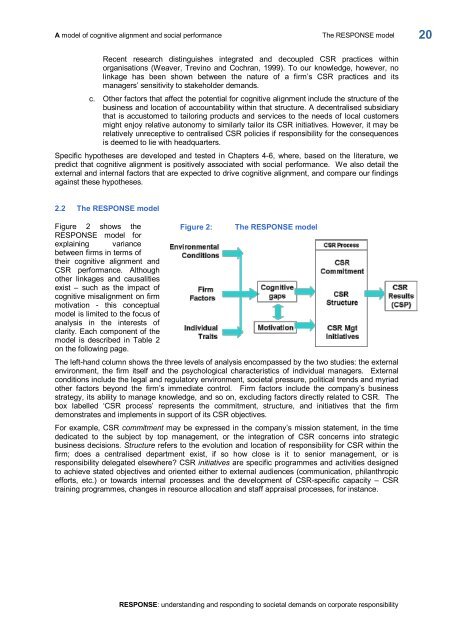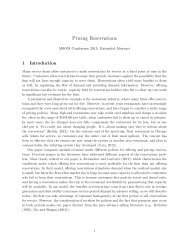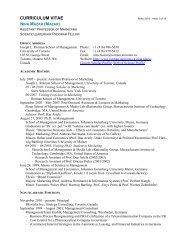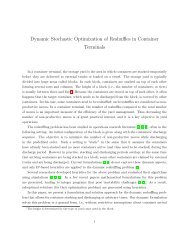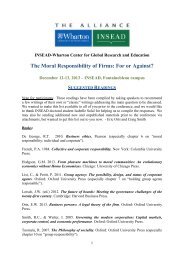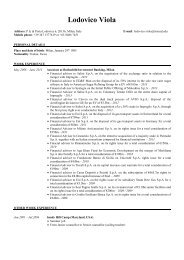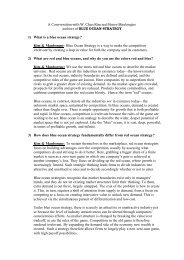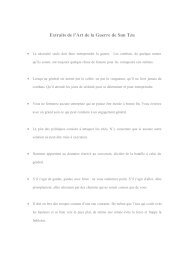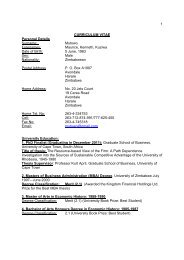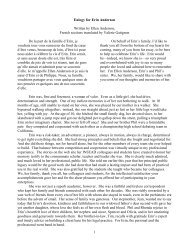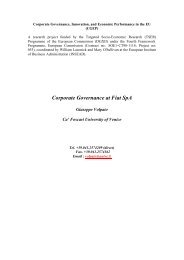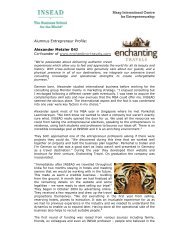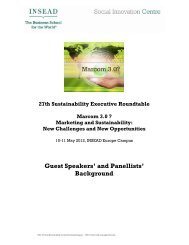RESPONSE - Insead
RESPONSE - Insead
RESPONSE - Insead
You also want an ePaper? Increase the reach of your titles
YUMPU automatically turns print PDFs into web optimized ePapers that Google loves.
A model of cognitive alignment and social performance The <strong>RESPONSE</strong> model<br />
Recent research distinguishes integrated and decoupled CSR practices within<br />
organisations (Weaver, Trevino and Cochran, 1999). To our knowledge, however, no<br />
linkage has been shown between the nature of a firm’s CSR practices and its<br />
managers’ sensitivity to stakeholder demands.<br />
c. Other factors that affect the potential for cognitive alignment include the structure of the<br />
business and location of accountability within that structure. A decentralised subsidiary<br />
that is accustomed to tailoring products and services to the needs of local customers<br />
might enjoy relative autonomy to similarly tailor its CSR initiatives. However, it may be<br />
relatively unreceptive to centralised CSR policies if responsibility for the consequences<br />
is deemed to lie with headquarters.<br />
Specific hypotheses are developed and tested in Chapters 46, where, based on the literature, we<br />
predict that cognitive alignment is positively associated with social performance. We also detail the<br />
external and internal factors that are expected to drive cognitive alignment, and compare our findings<br />
against these hypotheses.<br />
2.2 The <strong>RESPONSE</strong> model<br />
Figure 2 shows the<br />
<strong>RESPONSE</strong> model for<br />
explaining variance<br />
between firms in terms of<br />
their cognitive alignment and<br />
CSR performance. Although<br />
other linkages and causalities<br />
exist – such as the impact of<br />
cognitive misalignment on firm<br />
motivation this conceptual<br />
model is limited to the focus of<br />
analysis in the interests of<br />
clarity. Each component of the<br />
model is described in Table 2<br />
on the following page.<br />
Figure 2: The <strong>RESPONSE</strong> model<br />
The lefthand column shows the three levels of analysis encompassed by the two studies: the external<br />
environment, the firm itself and the psychological characteristics of individual managers. External<br />
conditions include the legal and regulatory environment, societal pressure, political trends and myriad<br />
other factors beyond the firm’s immediate control. Firm factors include the company’s business<br />
strategy, its ability to manage knowledge, and so on, excluding factors directly related to CSR. The<br />
box labelled ‘CSR process’ represents the commitment, structure, and initiatives that the firm<br />
demonstrates and implements in support of its CSR objectives.<br />
For example, CSR commitment may be expressed in the company’s mission statement, in the time<br />
dedicated to the subject by top management, or the integration of CSR concerns into strategic<br />
business decisions. Structure refers to the evolution and location of responsibility for CSR within the<br />
firm; does a centralised department exist, if so how close is it to senior management, or is<br />
responsibility delegated elsewhere? CSR initiatives are specific programmes and activities designed<br />
to achieve stated objectives and oriented either to external audiences (communication, philanthropic<br />
efforts, etc.) or towards internal processes and the development of CSRspecific capacity – CSR<br />
training programmes, changes in resource allocation and staff appraisal processes, for instance.<br />
<strong>RESPONSE</strong>: understanding and responding to societal demands on corporate responsibility<br />
20


